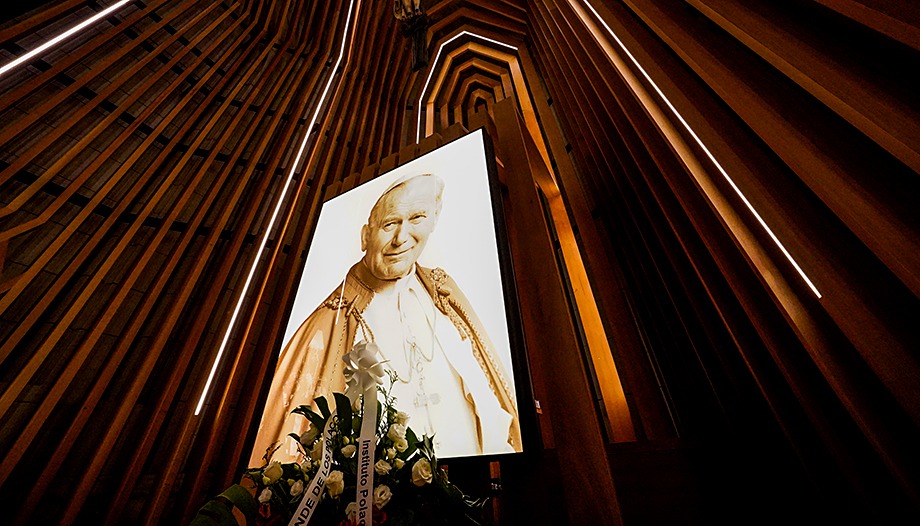Cathedrals are buildings designed to last "forever" and it is common that over the centuries works are carried out in them that, little by little, alter their physiognomy. When the cathedral of Santa María la Real de la Almudena there was a series of side chapels, one of which is the one that the Cathedral Chapter decided to dedicate to St. John Paul IIPope who dedicated the cathedral in 1993.
When the commission came to Cano and Escario's studio, there was already a first chapel that they decided to respect and they designed an interior envelope made with a series of wooden porches very close to each other that allow to see through it the original architecture but with a very subtlety achieved, because the visitor experiences being in a completely new chapel.
That is to say, Cano and Escario propose their performance as a scenic spatial plot within the space of a side chapel. This, in turn, is framed in the overall space of the cathedral.
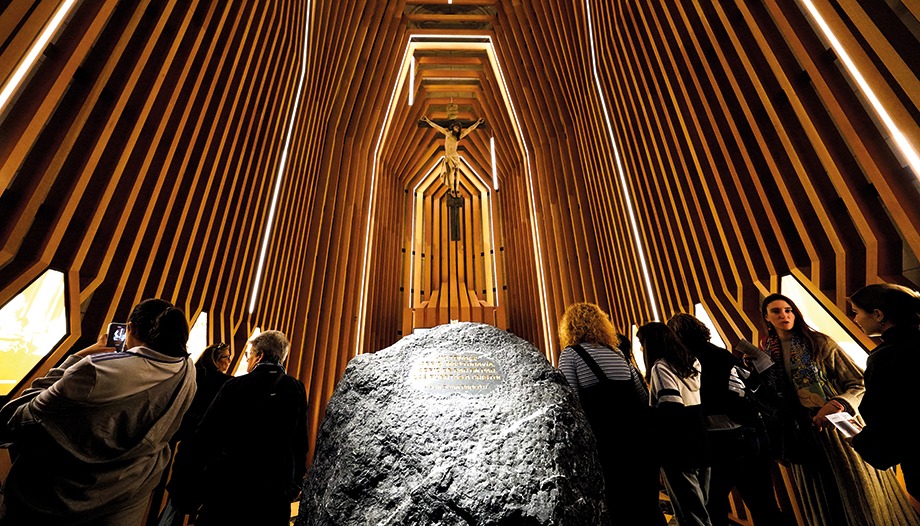
Symbolic elements
At the entrance to the chapel, there is a large rock that symbolizes the material dimension of creation. The marble rock, in addition to this significance, refers to the primacy of Peter and apostolic continuity.
Just behind this stone, like a boat, there is a longitudinal and narrow table on the far end of which there is a paschal candle, on whose vertical, attached from heaven or Abraham's bosom, hang three luminaries symbolizing the Holy Trinity.
Traditionally, stone was used in temples for the materialization of their vaults, symbolizing the celestial and/or sacred realm.
Here there is an apparent change, as Cano and Escario have opted for the use of wood, a choice of great interest and subtlety because, in essence, the idea is to symbolize the union of the faithful in the building of the church. If in some examples, the faithful are represented by the carved stones, here it is the pieces of wood in their successive porticoes, thirty centimeters apart from each other, that make the original chapel transparent: it is the Church in motion, in tradition and vibrantly current, configuring the structure of the Chapel, thus symbolizing the place of this world and the work of man in his design to dominate creation.
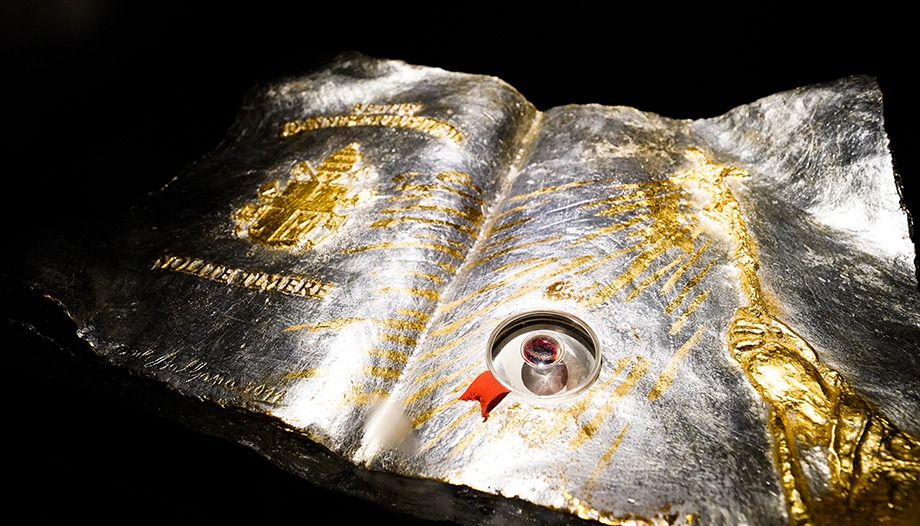
Joseph's workshop would also be represented here, recalling, in this wood, both the Church's commitment to creation and the Polish Pope's passion for forests and mountains.
St. John Paul II began his pontificate by commending the whole Church to the Virgin Mary with that memorable invocation ".Totus Tuus". (All yours). In this chapel, perhaps we miss, figuratively, that mystery of the virginal Marian presence. However, perhaps in a more cryptic way, in these Petrine settings we want to intuit, already reflected in its section, something like the maternal cloister of Our Mother, Saint Mary. In this sense, it should be noted that one of the novelties introduced by Christian architecture was that, unlike the classical temples of Greece and Rome, the faithful passed into the interior of the temple. This concept is embodied in the general conception of Christian churches in which, like a mother's womb, the faithful are engendered in the world of grace.
In this case, we can also see this gestating presence both in the floor plan and in the section. While in other chapels of the cathedral it is not possible to access its interior, but they are conceived only for observation, in this chapel of St. John Paul II we can establish an internal tour that tells us about the beginning and end of the significance of the symbols included.
The purity of the spiritual dimension is symbolized in the light emitted by the paschal candle and the lights interspersed as luminaries between the wooden porticoes that symbolize the dawn and the shadows of the life of the faithful and the saints, giving an impression of the background in perspective with its seriality. They are the milestones and lights that Providence marks on the path of wandering through this life until reaching the Father.
In this symbolic group, we can also understand that we are seeing the mystery of our redemption, in which Jesus Christ is incarnated in matter (rock) and after his life represented in the boat, which in turn is the Church, after his Ascension, he opened the way that leads to the encounter with God the Father.
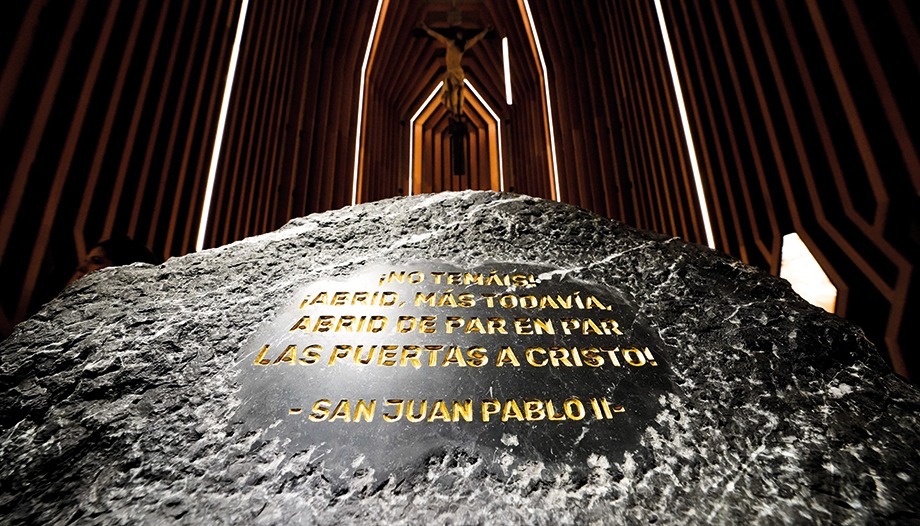
This wooden ascent breaks through the paths of life, from the beginning of the checkerboard floor to the zenith of redemption from which the Cross of Christ hangs.
Below it, as a sacramental preamble, there is a confessional for penitents.
The slats that rise from the ground plane towards it, break their path and directionality in a graceful itinerary, like children who are always playing in its presence.
These tables house in the lower part of the chapel some rhomboidal luminaries with photos of the life of the Pope or of the life of St. John Paul II as significant milestones of his history and passage through this life. These scenes from the life of the saint are like windows that open from his intimacy to the exterior space of the faithful.
At the back of the chapel there is a large photo of St. John Paul II behind which is located the space for the ministry of penance, which, together with the Eucharist and the other sacraments, is the way established by Jesus Christ to initiate our resurrection already in this life. This - the confessional - by grace elevates us penitentially to the Father. In other words, the penitent is thus transformed into an embryo destined to be born into eternal life. Man is thus shown to be the image and likeness of God, sanctified by grace and elevated to the supernatural order.
In this case, since it is a penitential chapel and there is no altar, this image remains as a frontal before the confessional, symbolizing the enormous dedication and appreciation for this sacrament in the life and teaching of Pope Wojtyła. As the Dean of the Cathedral pointed out at the inauguration, it would be a nice attitude of the visitor, before entering the chapel, that consideration of the saint to the young people who said: "enter, do not be afraid and open the doors to Christ"; words pronounced by him immediately after his accession to the Petrine ministry.
In one of the lateral rhombuses, also backlit, the reliquary that was kept in the cathedral of Madrid has been placed, in that first space dedicated to the Polish Pope, housing a vial with his blood.
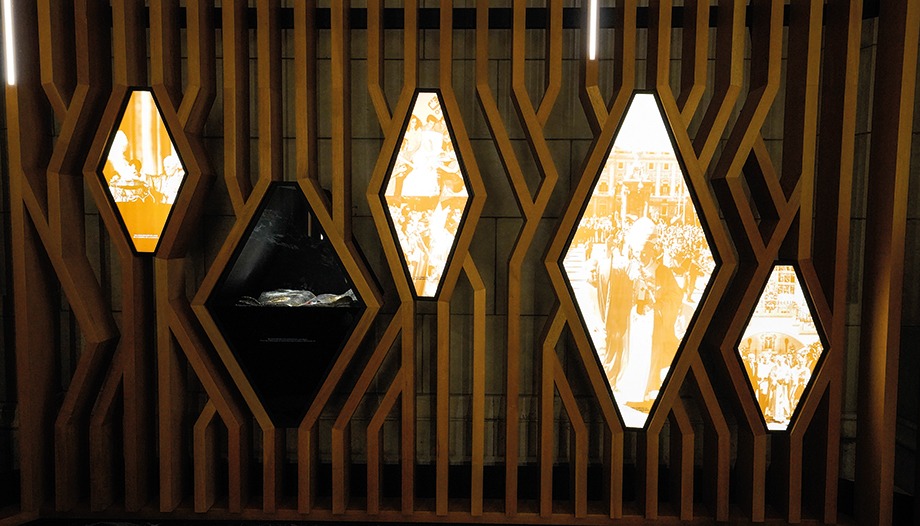
If we look at the formal aspects of the scenic plot that the chapel offers us, we could say that it has minimalist reminiscences, organic Nord-European architecture, conceptual art and a particular "manner" of arranging and conceiving things with a marked expressiveness.
There is a great formal purification that in turn reveals architecturally certain complexity and contradiction in the language used. The games and warps that the elements of the wooden porches in their coming and going, lowering and raising asymmetrically ... etc., attest to this.
We could also speak of a trace or symbolic air of the Holy Week processions, with a certain nocturnal effect of the same. Something like the collective unconscious that the artists, I do not know if willingly or unwillingly, have left captured. It is the archetypal dream of the sacred in man manifested by its symbolic rituals. Scenarios of a journey: the mystery of another presence.
Architect.




